Impulse Excitation Technique
Introduction to the impulse excitation technique
The impulse excitation technique (IET) is a non-destructive (NDT) material characterization method. This method is used to determine elastic properties, internal friction/damping (Q-1) and many other mechanical properties. Its versatile applications span a broad spectrum of materials. The methodology relies on analyzing the vibrations of a test sample or component following a gentle ‘impulse excitation’ or tap. Its inherent simplicity facilitates rapid and highly accurate characterization of mechanical properties. The technique is applied in diverse fields, including material science, research and development, and quality control/product inspection for both industrial and academic purposes.
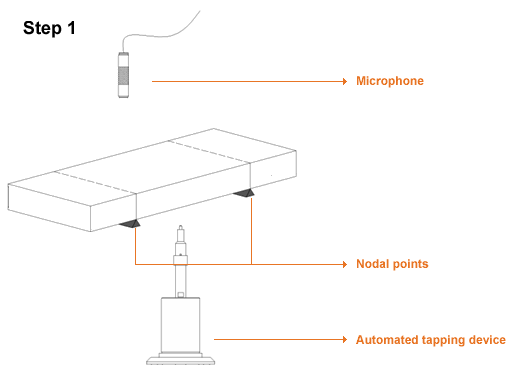
Background information
Any solid object has a characteristic set of mechanical resonant frequencies related to its mass, dimensions and elastic properties. The correlation between the elastic properties of a specimen and its mechanical resonance frequencies is a well-established fact. In case of homogeneous and isotropic samples, this relationship is straightforward. For simple sample geometries such as rectangular bars, cylindrical rods or discs elastic properties can be calculated with IET. By measuring the resonant frequencies of such sample, elastic properties like Young’s & shear moduli and Poisson’s ratio can be identified. For objects with a complex shape, this relationship is more complex. In that case the measurement information can be used for relative comparison. This method has been proven to be a powerful tool in quality control or product inspection.
The vibration signal can also be analyzed from the internal friction or damping point of view. This material property, denoted as the Q-1 factor provides information about the energy dissipation in the sample. Such property can be obtained from the amplitude decay of the free vibrating sample. More importantly, in contrast to the resonant frequency, this damping value is independent of the sample geometry.
The RFDA-method (Resonance Frequency & Damping Analyzer) involves analyzing vibrations triggered by a mechanical impulse. This non-destructive method is versatile and applicable under various conditions. these conditions vary from high temperatures to low temperatures, controlled humidity and many more. It even allows testing the same specimen through different thermal shock cycles to assess the impact of aging.
Measurement procedure
The RFDA method for impulse excitation testing requires a simple procedure based on just a few steps:
- Sample setup | A sample is positioned on supporting wires to allow a free vibration of the specimen. Specific positioning of the sample will allow the detection of multiple vibration modes.
- Impact & transducer positioning | By selecting the position of the excitation device and the microphone it is possible to select which vibration mode is predominant in the vibration signal.
- Measurement | The excitation device impacts the specimen wich induces a vibration in the sample. This vibration is detected by the transducer wich converts it to an electrical signal. The recorded signal is sent to the RFDA for signal conditioning and data-aqcuisition.
- Signal analysis | After data aqcuisition the PC-based RFDA software analyzes the signal in time domain and identifies the dominant frequencies. These dominant resonant frequencies are used to calculate elastic properties or to compare to the object’s frequency fingerprint in case of product inspection.
Elastic properties
Different resonant frequencies can be excited dependent on the position of the support wires, the mechanical impulse excitation method and the microphone.
There are two main vibration modes of interest:
Flexural vibration: Controlled by the Young’s modulus
Torsional Vibration: Controlled by the shear modulus for isotropic materials.
For predefined shapes like rectangular bars, discs, rods and grinding wheels, the dedicated RFDA software calculates the sample’s elastic properties using the sample dimensions, weight and resonant frequency (ASTM E1876-22).
Young’s modulus
To determine the Young’s modulus, the impulse excitation equipment measures the flexural vibration frequency (see picture) and calculates the Young’s modulus using the mass and dimensions of the sample according to the different measurements and standards (ASTM E1876-22, ISO 12680-1, EN 843-2).
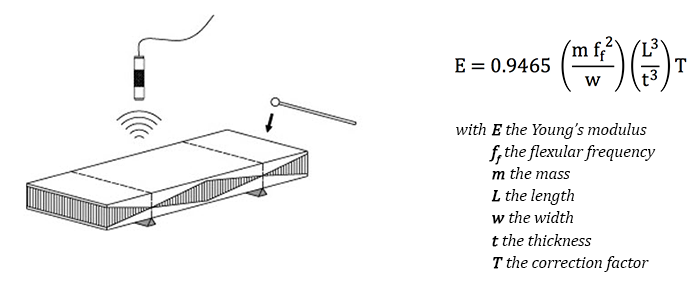
Shear modulus
To determine the shear modulus, the impulse excitation equipment measures the torsional vibration frequency (see picture) and calculates the shear modulus function using the mass and dimensions of the sample according to the different standards (ASTM E1876-22, ISO 12680-1, EN 843-2).
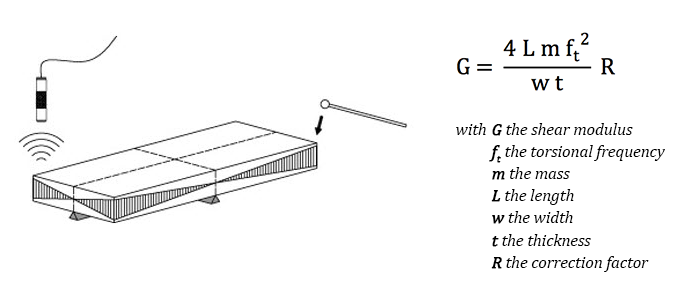
Poisson ratio
The Poisson’s ratio is a measure in which a material tends to expand in directions perpendicular to the direction of compression. After measuring the Young’s modulus and the shear modulus, the dedicated impulse excitation technique software determines the Poisson’s ratio using Hooke’s law which can only be applied to isotropic materials according to the different standards (ASTM E1876-22, ISO 12680-1, EN 843-2).
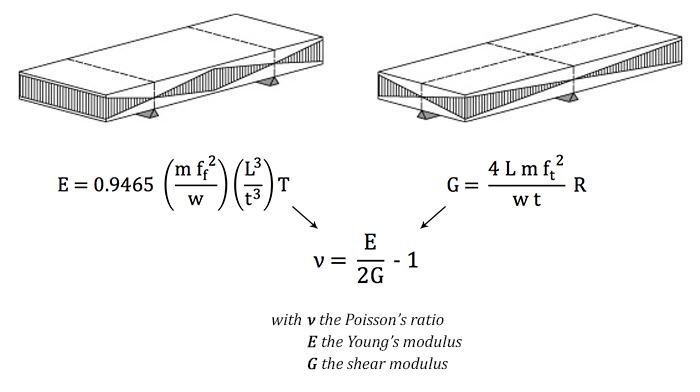
Internal friction
Material damping or internal friction is characterized by the decay of the vibration amplitude of the sample in free vibration as the logarithmic decrement. The damping behaviour originates from anelastical processes occurring in a strained solid i.e. thermoelastic damping, magnetic damping, viscous damping, defect damping,… For example, different materials defects (dislocations, vacancies,..) can contribute to an increase in the internal friction between the vibrating defects and the neighboring regions.
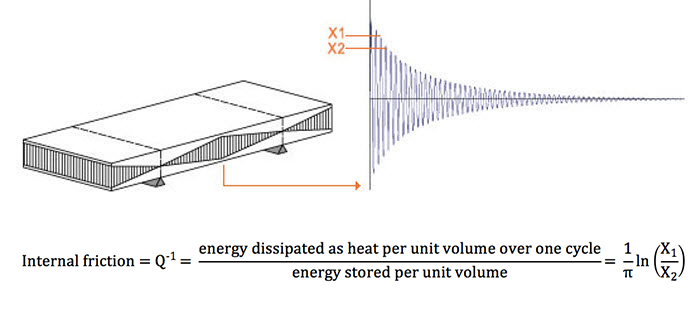
Advantages of impulse excitation technique
- Non-destructive impulse excitation measurements of elastic and damping properties
- Large temperature range: -80 °C – 1700 °C
- Reliable, fast and easy accessible measurement technique
- Limited restrictions on sample geometry and dimensions
- Applicable to porous and brittle materials due to small strains
- Information about internal structure, global behavior, damage,…
Application Domain
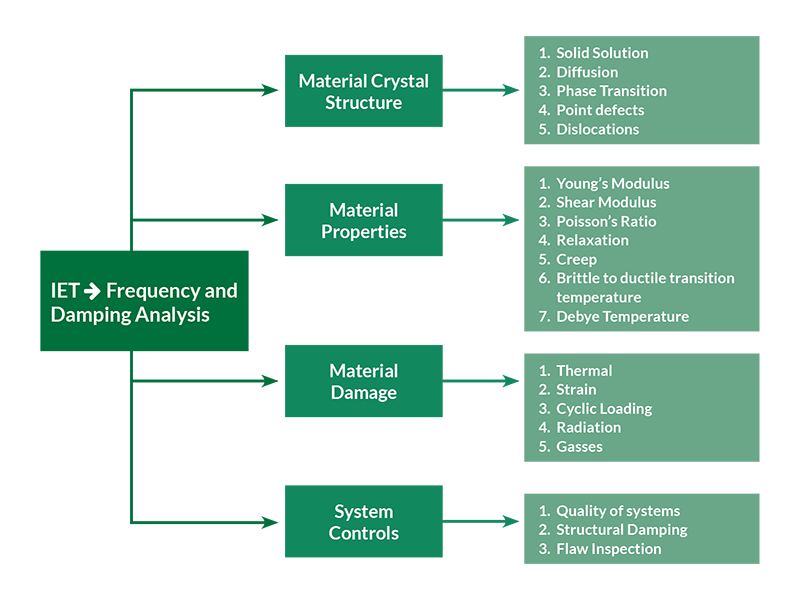
Relevant IET Standards
- ASTM standards
- ASTM E1876-22: Standard Test Method for Dynamic Young’s Modulus, Shear Modulus, and Poisson’s Ratio by Impulse Excitation of Vibration
- ASTM C1259-21: Standard Test Method for Dynamic Young’s Modulus, Shear Modulus, and Poisson’s Ratio for Advanced Ceramics by Impulse Excitation of Vibration
- ASTM C1548-02(2020): Standard Test Method for Dynamic Young’s Modulus, Shear Modulus, and Poisson’s Ratio of Refractory Materials by Impulse Excitation of Vibration
- ISO standards
- ISO 12680-1:2005: Methods of test for refractory products – Part 1: Determination of dynamic Young’s modulus (MOE) by impulse excitation of vibration
- ISO 20343:2017: Fine ceramics (advanced ceramics, advanced technical ceramics) – Test method for determining elastic modulus of thick ceramic coatings at elevated temperature
- EN standards
- EN 843-2:2006: Advanced technical ceramics – Mechanical properties of monolithic ceramics at room temperature – Part 2: Determination of Young’s modulus, shear modulus and Poisson’s ratio
- EN 820-5:2009: Advanced technical ceramics – Thermomechanical properties of monolithic ceramics – Part 5: Determination of elastic moduli at elevated temperatures
Learn more about the Impulse Excitation Technique
Let us guide you in the material testing possibilities of the Impulse Excitation Technique (IET) as well as the RFDA product line. Our experts are ready to help you out. You can expect us to:
- Answer any questions you might have
- Arrange a demo measurement on your own samples
- Demo’s of the RFDA product line
- And many more …
